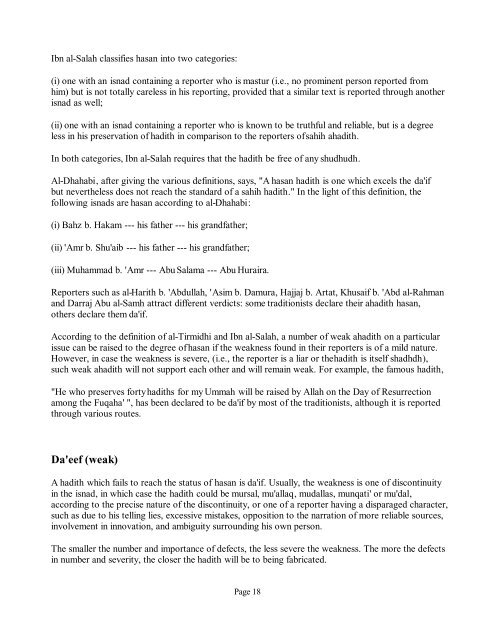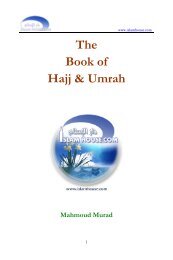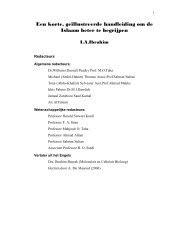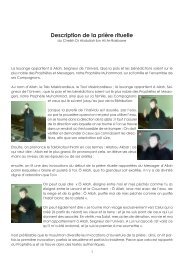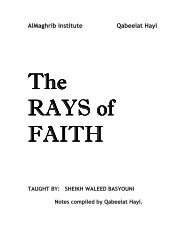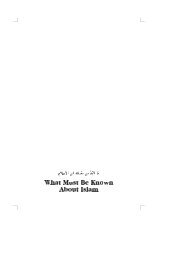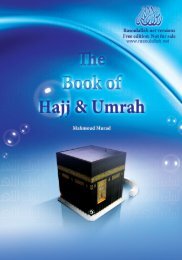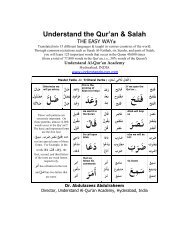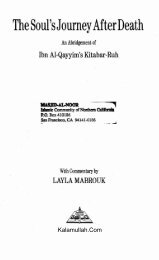Rules Governing The Criticism Of Hadith - Islam House
Rules Governing The Criticism Of Hadith - Islam House
Rules Governing The Criticism Of Hadith - Islam House
You also want an ePaper? Increase the reach of your titles
YUMPU automatically turns print PDFs into web optimized ePapers that Google loves.
Ibn al-Salah classifies hasan into two categories:<br />
(i) one with an isnad containing a reporter who is mastur (i.e., no prominent person reported from<br />
him) but is not totally careless in his reporting, provided that a similar text is reported through another<br />
isnad as well;<br />
(ii) one with an isnad containing a reporter who is known to be truthful and reliable, but is a degree<br />
less in his preservation of hadith in comparison to the reporters of sahih ahadith.<br />
In both categories, Ibn al-Salah requires that the hadith be free of any shudhudh.<br />
Al-Dhahabi, after giving the various definitions, says, "A hasan hadith is one which excels the da'if<br />
but nevertheless does not reach the standard of a sahih hadith." In the light of this definition, the<br />
following isnads are hasan according to al-Dhahabi:<br />
(i) Bahz b. Hakam --- his father --- his grandfather;<br />
(ii) 'Amr b. Shu'aib --- his father --- his grandfather;<br />
(iii) Muhammad b. 'Amr --- Abu Salama --- Abu Huraira.<br />
Reporters such as al-Harith b. 'Abdullah, 'Asim b. Damura, Hajjaj b. Artat, Khusaif b. 'Abd al-Rahman<br />
and Darraj Abu al-Samh attract different verdicts: some traditionists declare their ahadith hasan,<br />
others declare them da'if.<br />
According to the definition of al-Tirmidhi and Ibn al-Salah, a number of weak ahadith on a particular<br />
issue can be raised to the degree of hasan if the weakness found in their reporters is of a mild nature.<br />
However, in case the weakness is severe, (i.e., the reporter is a liar or the hadith is itself shadhdh),<br />
such weak ahadith will not support each other and will remain weak. For example, the famous hadith,<br />
"He who preserves forty hadiths for my Ummah will be raised by Allah on the Day of Resurrection<br />
among the Fuqaha' ", has been declared to be da'if by most of the traditionists, although it is reported<br />
through various routes.<br />
Da'eef (weak)<br />
A hadith which fails to reach the status of hasan is da'if. Usually, the weakness is one of discontinuity<br />
in the isnad, in which case the hadith could be mursal, mu'allaq, mudallas, munqati' or mu'dal,<br />
according to the precise nature of the discontinuity, or one of a reporter having a disparaged character,<br />
such as due to his telling lies, excessive mistakes, opposition to the narration of more reliable sources,<br />
involvement in innovation, and ambiguity surrounding his own person.<br />
<strong>The</strong> smaller the number and importance of defects, the less severe the weakness. <strong>The</strong> more the defects<br />
in number and severity, the closer the hadith will be to being fabricated.<br />
Page 18


